Season’s greetings from the Multi-Story Water team! Here’s a little watery (rather than snowy) Christmas card image…
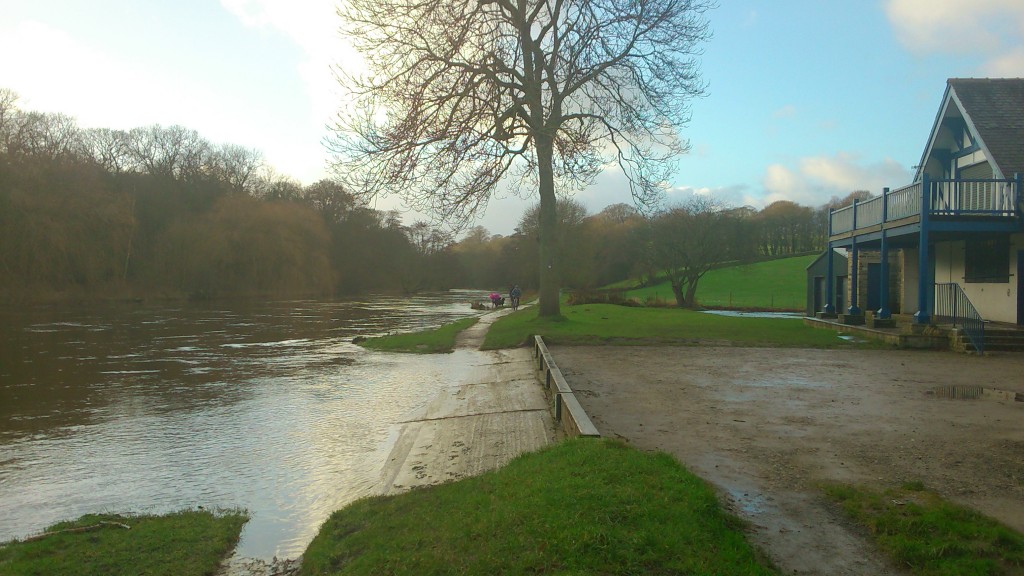 This was taken last Friday, December 19th, on the bank of the Aire outside the Bradford Rowing Club (right). It had been raining in the Bradford area, but it must have been raining a whole lot more further upstream, because as you can see the river was high enough to have broken its banks here. Cyclists were having to navigate around the waterlogged path (see immmediate foreground). Meanwhile, just a few yards downstream, this was the view of Hirst Weir…
This was taken last Friday, December 19th, on the bank of the Aire outside the Bradford Rowing Club (right). It had been raining in the Bradford area, but it must have been raining a whole lot more further upstream, because as you can see the river was high enough to have broken its banks here. Cyclists were having to navigate around the waterlogged path (see immmediate foreground). Meanwhile, just a few yards downstream, this was the view of Hirst Weir…
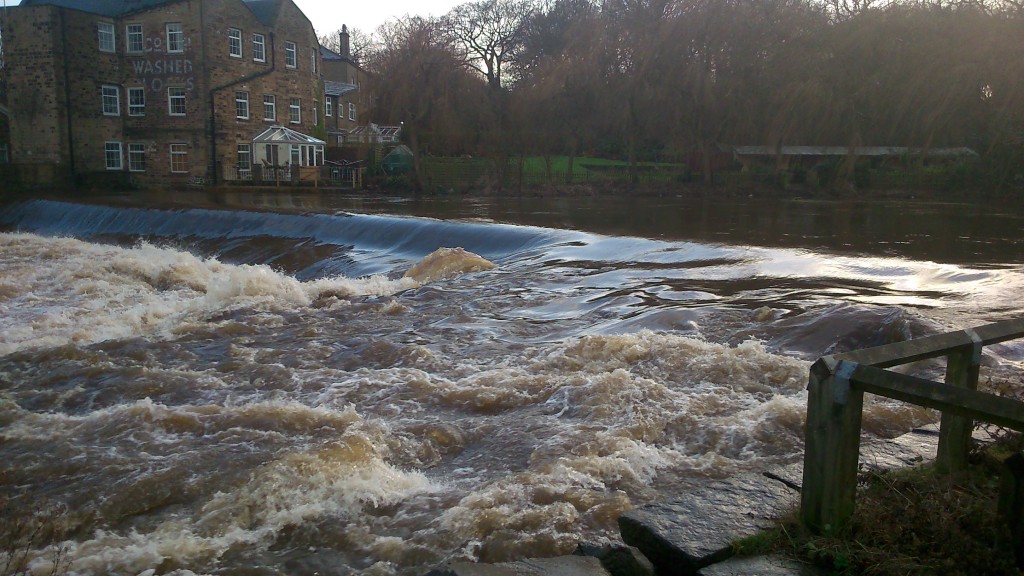 The water’s so high that in the foreground the weir has almost disappeared. Those familiar with this weir will remember that it was seriously damaged during the high water of summer 2012, necessitating a patch-up repair job by the rowing club (which now owns the whole of the weir – under the holding company Hirst Weir Ltd.). A huge pile of rocks was lowered into the river on the nearside (nearside for this photo), making a more gradual descent for the water. In this shot above the rocks are, unusually, all but invisible because of the height of the river. Now, take look at this…
The water’s so high that in the foreground the weir has almost disappeared. Those familiar with this weir will remember that it was seriously damaged during the high water of summer 2012, necessitating a patch-up repair job by the rowing club (which now owns the whole of the weir – under the holding company Hirst Weir Ltd.). A huge pile of rocks was lowered into the river on the nearside (nearside for this photo), making a more gradual descent for the water. In this shot above the rocks are, unusually, all but invisible because of the height of the river. Now, take look at this…
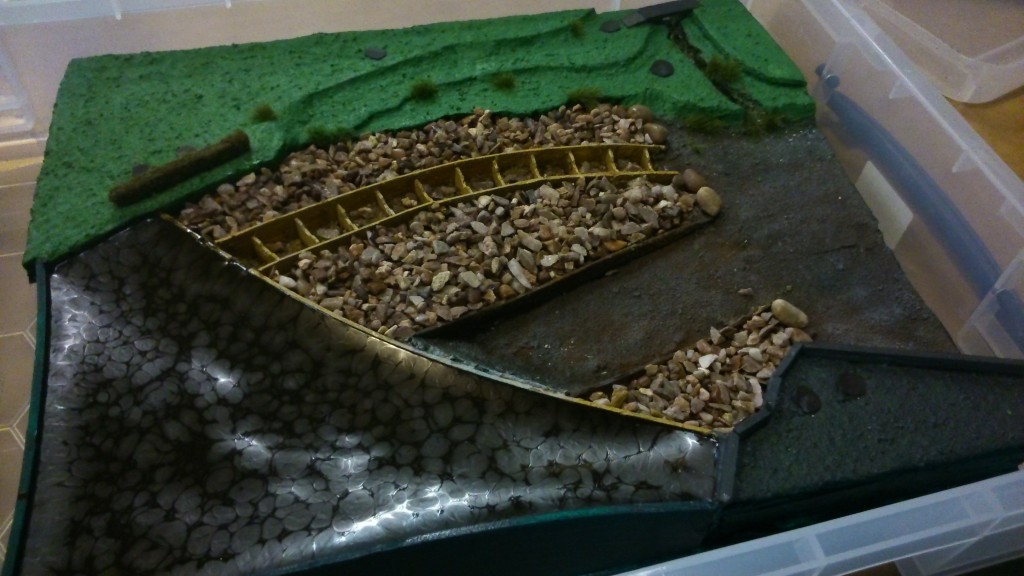 This is the model box owned by the rowing club, showing their design for the planned, permanent reconstruction job on the weir. (For bearings: the mill is bottom right, the mouth of Loadpit Beck top right.) As you can see, the engineering solution being proposed is essentially to extend the use of loose rocks across the full width of the river, downstream of the weir, so as to make the water’s descent more gradual and thus less impactful on the river bed. (The middle section in the model, without loose stones, is there simply to illustrate the height of the drop at present – it won’t be built like that!). The laddered element at the top of the image is a fish pass design, which has helped secure Environment Agency approval for the plans. One can imagine, more broadly, that the EA approves of the design anyway, since the more gradual decline being created for the ‘new’ riverbed achieves the next best thing to a restoration of the river’s natural flow (presumably over time the river will wear the rocks themselves smoother, deposit silts on them, etc). Of course, the one thing the rowing club would not countenance is the removal of the weir, since their activities are entirely dependent on the 650m stretch of straight, flat water upstream that it permits on the upstream side. Anything less than that and they wouldn’t have a viable racing course (as it is, 650 is a modest sprint, compared to the international standard 2000m course at, say, Eton Dorney). It’s for this very reason – the centrality of the weir to the club’s existence – that they took over responsibility for the whole weir a number of years ago. Previously of course it belonged to the mill and its inheritors, but after previous damage to the weir in 2002, a repair grant from Sport England could only be secured if the weir was legally a public rather than private asset. Hence the club taking on responsibility — they they sensibly ensured arm’s-length liability by setting up the holding company.
This is the model box owned by the rowing club, showing their design for the planned, permanent reconstruction job on the weir. (For bearings: the mill is bottom right, the mouth of Loadpit Beck top right.) As you can see, the engineering solution being proposed is essentially to extend the use of loose rocks across the full width of the river, downstream of the weir, so as to make the water’s descent more gradual and thus less impactful on the river bed. (The middle section in the model, without loose stones, is there simply to illustrate the height of the drop at present – it won’t be built like that!). The laddered element at the top of the image is a fish pass design, which has helped secure Environment Agency approval for the plans. One can imagine, more broadly, that the EA approves of the design anyway, since the more gradual decline being created for the ‘new’ riverbed achieves the next best thing to a restoration of the river’s natural flow (presumably over time the river will wear the rocks themselves smoother, deposit silts on them, etc). Of course, the one thing the rowing club would not countenance is the removal of the weir, since their activities are entirely dependent on the 650m stretch of straight, flat water upstream that it permits on the upstream side. Anything less than that and they wouldn’t have a viable racing course (as it is, 650 is a modest sprint, compared to the international standard 2000m course at, say, Eton Dorney). It’s for this very reason – the centrality of the weir to the club’s existence – that they took over responsibility for the whole weir a number of years ago. Previously of course it belonged to the mill and its inheritors, but after previous damage to the weir in 2002, a repair grant from Sport England could only be secured if the weir was legally a public rather than private asset. Hence the club taking on responsibility — they they sensibly ensured arm’s-length liability by setting up the holding company.
If you’re wondering how I know so much about this all of a sudden, it’s because of meeting this man, Barry Wood (below). Barry is a self-effacing sort of person who didn’t really want his picture taken, but was happy to be seen in long shot surrounded by this view of the upstairs of the clubhouse. He has been a member here since 1957 — that’s 57 years! — so what he doesn’t know about this rowing club isn’t worth knowing…
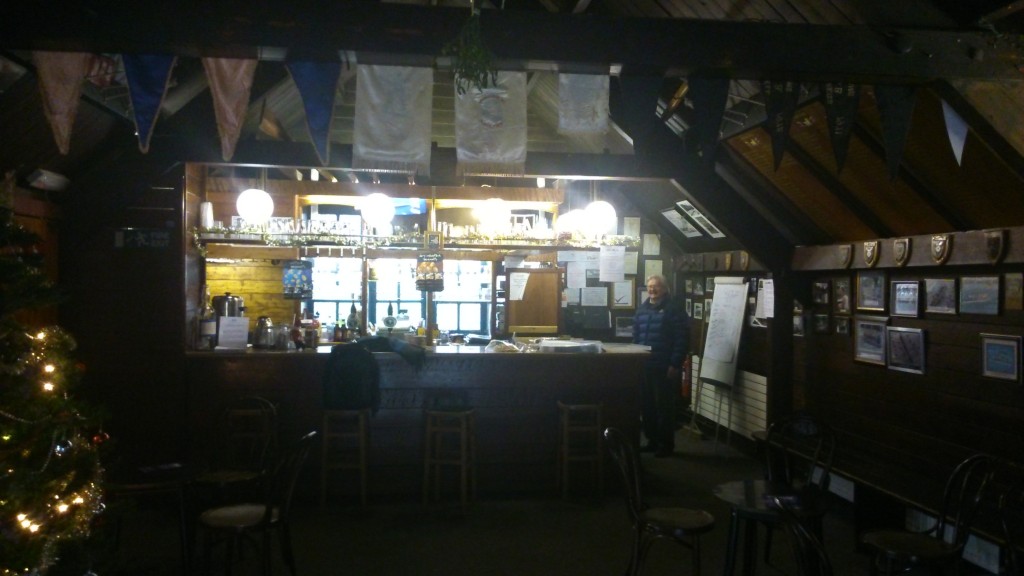 I’d been advised by my friend Eddie Lawler that Barry was the man to speak to about the club and its history, since we want to include something about it in the audio tour of the area that we’re developing (see previous post). Barry to be very generous with his time and thoughts, and it was a treat to talk to him. I didn’t like to ask a gentleman his age, but Barry says he had already been through a full education and National Service before joining the club, so he must now be pushing 80. You wouldn’t know it to look at him, though, and he maintains a very active role in the club — indeed he’s one of the three company directors of Hirst Weir Ltd!
I’d been advised by my friend Eddie Lawler that Barry was the man to speak to about the club and its history, since we want to include something about it in the audio tour of the area that we’re developing (see previous post). Barry to be very generous with his time and thoughts, and it was a treat to talk to him. I didn’t like to ask a gentleman his age, but Barry says he had already been through a full education and National Service before joining the club, so he must now be pushing 80. You wouldn’t know it to look at him, though, and he maintains a very active role in the club — indeed he’s one of the three company directors of Hirst Weir Ltd!
No less extraordinary is the clubhouse itself — originally built in 1893 on the south side of the river, it was dismantled brick by brick and ferried across the river in 1922, to be built exactly as it had been (except that, now facing south, they moved the roof gable to the other end of the building so that it was still facing upstream to the racing!). This reconstruction was forced when the new owners of Hirst Mill demanded the club vacate their land, but Salts of Saltaire allowed them a spot on the opposite bank (which the club now owns). When Barry came here in 1957, the clubhouse was still very simple — with no gas, no electric, no running water — all of which has been installed during his time with them.
Now the next priority is to get that weir fixed up permanently, and for this, funds are going to be urgently needed. Hence this banner poster in the clubhouse itself…
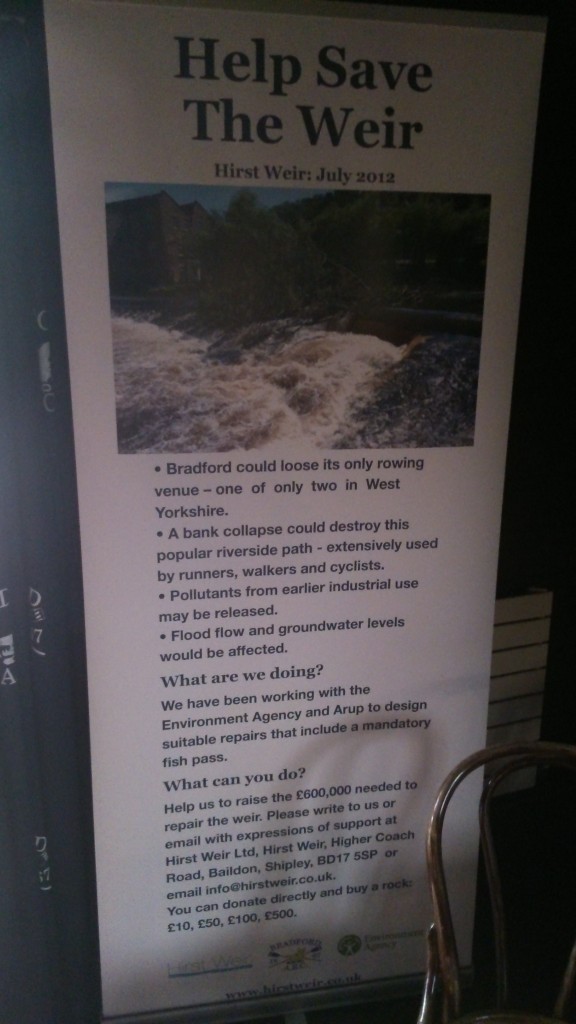 If you can chip anything in to the appeal, please do! I’m sure the rowing club would appreciate the gift, because the river isn’t going to stop pressuring at that weir any time soon…
If you can chip anything in to the appeal, please do! I’m sure the rowing club would appreciate the gift, because the river isn’t going to stop pressuring at that weir any time soon…

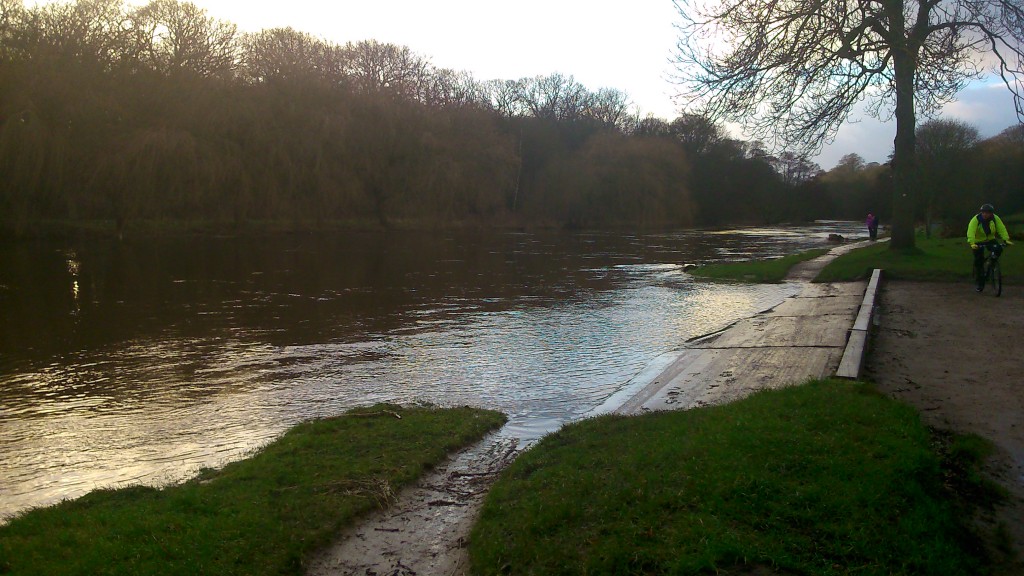
Hi
On my Google search fo Shipley and canals your website came up so you may or may not be able to help me in my family history research. I am the 4x great neice of Samuel Dixon who was a Warfinger in Shipley he died in 1884.He was brought up in The Bull and Dog pub which I know has been turned into flats , my husband managed to take a quick photo of the cellar a few years ago during the conversion when we were exploring and trying to find our bearings around Shipley .
We live about 70 miles away and so we are not very familiar with Shipley except to say we know the town centre was reconfigured in perhaps the 1960s? Or 1970s
I was wondering if in all the work you have done about the waterways you have found out any information on Samuel Dixon . He died a wealthy man £4 million in todays money and was a long life batchelor but strangly his housekeeper Mary Helliwell spinster is interred in his grave at the Parish Church. He gave her the use of his house 24 Bradford Rd until death.the plot thickens !
If you have found out anything about him I would love to know .I think he was in partnership with a Mr Crabtree. As with all family inheritances the trust fund he set up for his extended family has long gone. Thanks and I hope I hear from you or perhaps you can point me in the right direction to someone who can
Caroline